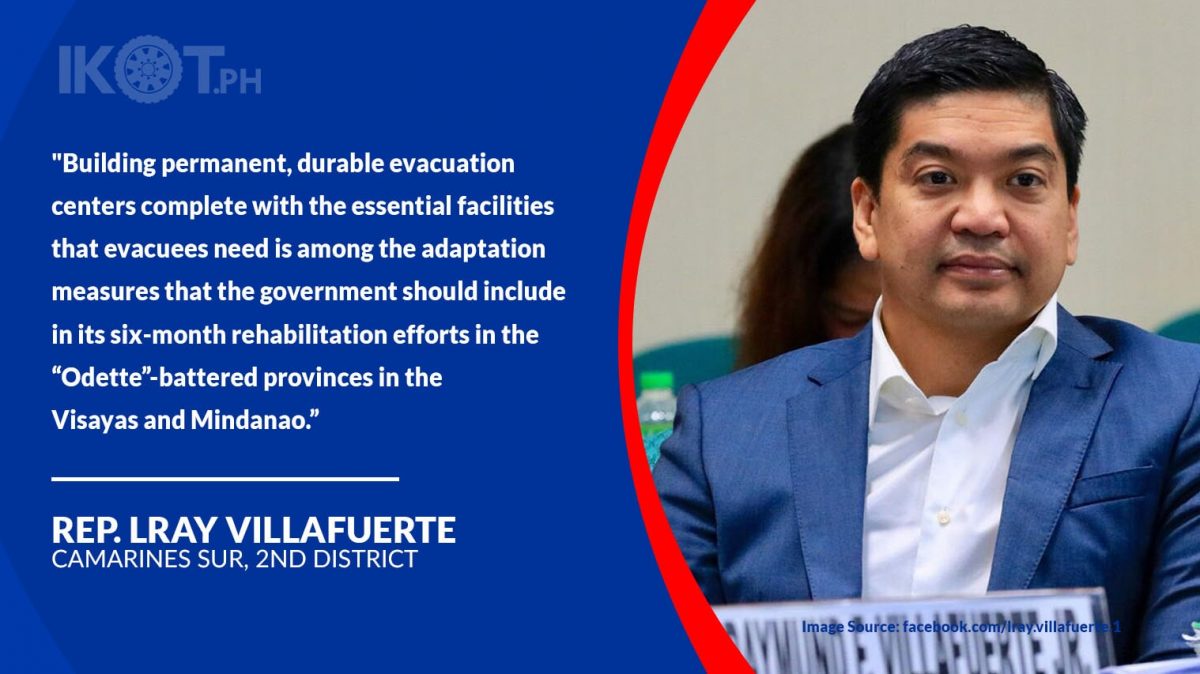The government’s plan to focus over the next six months on rehabilitation efforts for provinces devastated by typhoon “Odette” should incorporate the construction of permanent and durable evacuation centers to ensure that these structures would be in place before the end of the Duterte administration’s term in June next year, Camarines Sur Representative LRay Villafuerte said.
“Rehabilitation should not only cover the reconstruction of typhoon-damaged infrastructure but should also consider adaptation measures to help safeguard people from future calamities,” Villafuerte said.
Villafuerte has been pushing the construction of permanent evacuation centers as early as 2018 when typhoon “Ompong” struck Bicol and several regions in Luzon.
“Building permanent, durable evacuation centers complete with the essential facilities that evacuees need is among the adaptation measures that the government should include in its six-month rehabilitation efforts in the “Odette”-battered provinces in the Visayas and Mindanao,” he added.
Villafuerte said the initial construction of these permanent evacuation centers can be sourced from the P10 billion that the Department of Budget and Management (DBM) said would be made available for the rehabilitation of “Odette-“ravaged provinces.
According to reports quoting Cabinet Secretary and Acting Presidential Spokesman Karlo Nograles, the Duterte administration last week committed to working “as fast as possible” in completing whatever it can in rehabilitating these typhoon-hit areas before the President steps aside on June 30.
President Duterte declared a state of calamity on Dec. 21 in six “Odette”-battered areas: Regions 4B (Mimaropa–Mindoro, Marinduque, Romblon and Palawan), 6 (Western Visayas), 7 (Central Visayas), 8 (Eastern Visayas), 10 (Northern Mindanao) and 13 (Caraga).
The Department of Social Welfare and Development (DSWD) reported on its official Facebook page that over 285,ooo people or nearly 71,000 families spent their Christmas in a total of 1,204 evacuation centers across 10 regions affected by “Odette.”
Villafuerte has been pushing the construction of permanent evacuation centers as early as 2018 when typhoon “Ompong” struck Bicol and several regions in Luzon.
Earlier, Villafuerte welcomed the passage by the House of Representatives of a measure paving the way for the construction of such permanent evacuation centers across the country, especially in his disaster-prone home region of Bicol, and appealed to senators to immediately consider passing a counterpart bill in the Senate for the benefit of would-be displaced families in future natural calamities.
Villafuerte said building these evacuation centers will avoid the situation wherein families dislocated because of natural calamities become stuck in public schools or other temporary shelters without adequate facilities for months after their displacement.
Under House Bill (HB) No. 8990, the Department of Public Works and Highways (DPWH) will be in charge of building the evacuation sites, while local city and municipal governments shall be responsible for running and maintaining the centers.
The National Disaster Risk Reduction and Management Council (NDRRMC) will serve as the lead agency.
Evacuation centers have to be constructed in all cities and municipalities to serve as immediate and temporary shelter for people who have been evacuated or displaced because of emergencies such as typhoons, floods and fire, among others, the bill states.
Under the measure, evacuation centers should withstand wind speed of at least 300 kilometers per hour (kph) and moderate seismic activity of at least 8.0-magnitude, said Villafuerte, who was among the principal authors of the bill.
Facilities should have cubicles that could house at least five families, restrooms, centralized kitchen and laundry areas, a generator, and sufficient water supply, Villafuerte added.
Villafuerte said building these evacuation centers will avoid the situation wherein families dislocated because of natural calamities become stuck in public schools or other temporary shelters without adequate facilities for months after their displacement.


